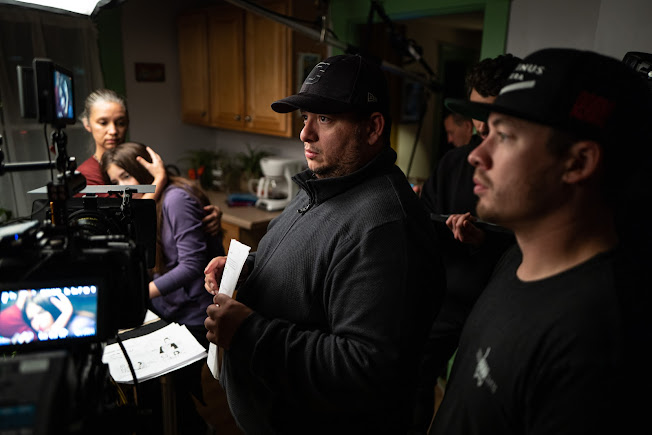 |
| 'Culantro Fino' director Fernando Lopez, center, setting up a shot. Photo: Zac Popik >>> |
Fernando Lopez’s short film Culantro Fino catches you off guard. At its heart, it’s a simple story about a mother and daughter searching for connection through the power of food. But there is so much more going on between mother and daughter, played by Sarah Carleton and Sophia Castellanos, respectively. Complex issues and complicated relationships familiar to any family dealing with with the threat of deportation.
All of that was by design, explains Lopez. “We wanted to take a complex premise and convey it in a simple way, without letting technology overshadow the tenderness of the relationship or the subtext of the plot.”
The film is also an exploration of migrant life Lopez doesn’t often see portrayed on screen.
“There always seems to be an element of joy and euphoria when our culture is portrayed on screen, which is not wrong or inaccurate,” Lopez says. “But there are other versions of the Latino life in this country. Long hours working in restaurants, landscaping, diverse but dysfunctional partnerships and families, language barriers, and so forth.”
We sat down with Lopez recently to learn more about Culantro Fino and the simply complex filmmaker behind the project.
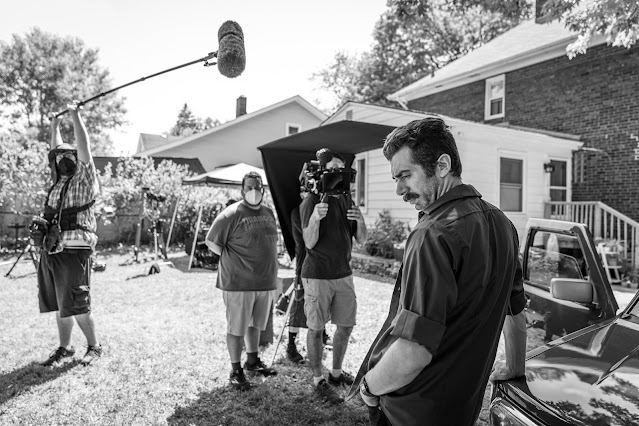
On the set of Fernando Lopez's 'Nickel and Diming' Photo: Zac Popik
From San Pedro Sula, Honduras, to Cleveland, Ohio
Midwest Movie Maker: Tell us a little bit about yourself.
Fernando Lopez: I'm originally from San Pedro Sula, Honduras. Growing up, my mom was a consummate artist, a painter, and a sculpturist. She always included us in her projects. We were always exposed to her colleagues' work, and she encouraged us to be creative. My father is an engineer, which would probably explain why filmmaking became my outlet.
We migrated from Honduras in 1999. I moved to Cleveland with my mom and my siblings. It was challenging to leave everyone I knew behind. Being involved in my mom's network of artist friends was the best way to transition into a new culture.
I went to Lincoln-West High School on the west side of Cleveland, where I learned the language and made friends from all over the world: Vietnam, Jordan, Albania, Costa Rica, Libya, and many more.
Being exposed to so many different cultures as I was learning the language really had an impact on me. There are so many stories I heard from all over the world, some of which I think about every day, 20-some years later.
MMM: When did you realize you wanted to be a filmmaker?
FL: Unlike many of my colleagues, I did not know I wanted to be a filmmaker until I got my first smartphone with a video camera. Growing up in Honduras, having a camera was not really an option, so it never even crossed my mind.
I got an iPhone around 2009, learned to edit some clips, how to use music and images to evoke emotion, and at the family holiday party in 2010, I played a video for my relatives. I collected videos from all over the place, archival photos from back home, when we were kids, and I edited in a way that told the story of migrants, the story of a family divided geographically, but still hanging on to the values and customs that we refuse to forget.
I remember editing it to a song by the Killers called Human which, looking back, I couldn't even tell you how I landed on that song. I probably couldn't name another song by that band. But it worked!
When the video ended, I looked back and half the room was clapping, others crying, laughing. "Wow!" I thought. "I can do that?"
And then I really worked hard at learning how to write screenplays. I spent endless hours on YouTube learning about framing, editing, and specifically the cadence of dramatic storytelling.
MMM: Did you go to film school?
FL: I did not go to film school. I simply did not see the benefit of it at the time. I wasn't sure that I wanted to be a filmmaker. I'm still not sure if I get to say that about myself. I really just wanted to keep filming, keep telling stories, and develop my own style.
Part of me felt that going to school would somehow pollute the purity of my motivation. Working in restaurants for a long time, I learned that there's a common understanding and difference between those who simply cook and those who went to culinary school, or chefs, as they like to be called.
Chefs tend to be a lot more structured, disciplined, but I always noticed that they were somewhat slower and not very open to new ideas.
Well, for some reason, I felt that if I went to film school, I would be like a chef; limited in my understanding of the craft based on what my professors would teach, or not open to new concepts. Of course, I was wrong. Some of the best filmmakers I know went to film school, namely Kent State, and are brilliant, professional, and could not be more inspiring. But back then I did not know any film school graduates, so I often think about what could've been.
MMM: Did you teach yourself? Did you have a mentor?
FL: YouTube! Honestly, I can't say it enough, YouTube has taught me so much of what I know. From screenwriting to color grading, I've learned a lot from YouTube. I'm not ashamed to admit it. I know there's a certain stigma that comes with that, and I'm here for it.
That said, I've worked with the same group of people for a long time, and some of these filmmakers have pretty much exploded in their respective crafts. Gaffers, DPs, sound, editors, other directors, and so forth. I know that every time I'm on a set, I'm going to school while working with them. Some have a technical understanding of the tools, others have a keen eye for executing the story in ways I could not imagine. All are generous in sharing their know-how and experience on and off set.
Later I became close friends with local writer and director Bobby Putka and film editor Ben Measor. Along with my good friends, long-time collaborators Joe Martin, Tim Figueira, and actor Sarah Carleton, they have had the biggest influence on me. Their support, constant lessons, constructive feedback, challenges, and friendship have really taught me more about filmmaking than any YouTuber, book or film set I've been a part of.
MMM: Tell me a bit about your early work. Share some mistakes, what you learned from them, and some triumphs, and what you learned from those.
FL: My first film was a black-and-white short I worked on with my cousin. We shot it with just the two of us, a couple of actors, a couple of extras, and two locations. I remember as we edited, we noticed that the actor had his glasses on for an entire scene, so we had to re-schedule that whole scene for a reshoot but without the glasses. We essentially forgot to ask him to take his glasses off.
After that, we put together a 48 Hour Film Project team with some guys I met through networking events, and by helping on another film set. That short film we shot won the Audience Award at the Cleveland 48HFP which was pretty cool.
At the screening and awards events for the 48HFP, I quickly learned that half of this job is networking, so I tried to connect with as many people as I could, help on as many sets as I could, and also make as many camera tests and short films as I could. I don't know that it worked, but I know that it helped build some strong relationships with other filmmakers. Some of those collaborations are still active 10 years later.
MMM: Your latest short is Culantro Fino. What inspired you to make the film?
FL: Culantro Fino came from an alternate universe in which I write and direct a feature-length film. It takes place a few years after a story that I've been working on for the last couple of years.
I don't see more human representations of Latino, migrant families on screen. There always seems to be an element of joy and euphoria when our culture is portrayed on screen, which is not wrong, or inaccurate, but there are other versions of the Latino life in this country. Long hours working in restaurants, landscaping, diverse but dysfunctional partnerships and families, language barriers, and so forth.
We wanted to take a complex premise and convey it in a simple way, without letting technology overshadow the tenderness of the relationship or the subtext of the plot.
MMM: The film is simple but emotionally powerful. How did you capture all of those emotions in what would normally play as an evening with a mom and her daughter?
FL: The script was only five pages, but the entire universe of this story was discussed with the actors, and an additional screenplay was made available to them in which the events of the father being detained take place. Sarah and Sofia also had time to do table reads, and time to discuss the story amongst themselves. I was in constant communication with them leading up to the shoot.
Two other elements that help my process are rehearsals close to the shoot date on location, as well as using long takes with multiple runs per take. This allows adjustment without the distraction of resetting lights, makeup, props, checking batteries, media, and so forth. Not that any of these other aspects are ignored, but I find that after a couple of runs, actors begin to really let go of their doubts about the characters. They stop worrying about their marks and their lines. Then emotion and subtext become a lot more palpable.
I also find myself providing direction mid-run, which can be challenging for a lot of actors, but it is very helpful when there are unexpected ideas, or after you feel you have what you need and you can afford to experiment.
MMM: For those of us unfamiliar with the realities of deportation and immigration in the U.S., can you share moments in the film that those familiar with that experience would recognize?
FL: Certainly! One of the biggest challenges when dealing with deportation or the threat of deportation is finding legal representation. But an even bigger challenge is finding the money to pay for it.
Early in the film, we see a stack of letters from the USCIS or Department of Homeland Security. We also see invoices from an immigration law firm. These are standard immigrant family correspondence. I still guard my residence and citizenship correspondence safely and consider it to be an important period of my life.
In the film, the mother is in financial distress, talks about not getting enough hours at work, and even ordering takeout for her and her daughter is something she has to really think about - all while sheltering her daughter, who is already suffering physically and emotionally. I prefer a viewer miss these subtleties completely, rather than misinterpret them as melodramatic or exaggerated, which they are not at all.
The financial toll of deportation or even the threat of deportation on a family can be traumatic, not unlike an unexpected death in the family, a bad divorce, or bankruptcy.
MMM: The final shot is quite moving, as well. Can you tell me more about it?
FL: Our idea was to visually highlight the physical wound and to leave the frame be for a few seconds while the mother is in the background scrambling. I think this is a very clear representation of what they are going through as a family: the pain, the stress, the uncertainty, and a void that can be difficult to ignore.
MMM: What’s next for you?
FL: I'm working on a feature documentary that I filmed in Honduras. It is about a doctor from Akron who moved south to have a life that matched his personality. It touches on the practice of medicine on a relatively remote island, his personal struggles adapting to that society, and it also explores the subject of immortality. I'll be sharing some of that content as we round third, but it is taking a lot more time and work, though we are super excited to share it!
MMM: How would you like to see your film career grow?
FL: At this stage, I would trade growth for consistency in my career. It makes me very happy to put out smaller, meaningful projects. Projects that I work on with my friends and projects that connect with people because of the subject matter, not because of the technique, the success, or the virality of the final product. Would it be nice to have a budget and make my version of Don Quixote in a modern world, chasing evil corporations instead of windmills? Sure! But I would not want to sacrifice the pleasure I get out of my current way of working for half of that.
MMM: Final thoughts?
FL: I really appreciate the opportunity to talk about our work, our process, my friends, and thoroughly enjoyed our conversation. People can follow me on Instagram and YouTube.
MMM: When did you realize you wanted to be a filmmaker?
FL: Unlike many of my colleagues, I did not know I wanted to be a filmmaker until I got my first smartphone with a video camera. Growing up in Honduras, having a camera was not really an option, so it never even crossed my mind.
I got an iPhone around 2009, learned to edit some clips, how to use music and images to evoke emotion, and at the family holiday party in 2010, I played a video for my relatives. I collected videos from all over the place, archival photos from back home, when we were kids, and I edited in a way that told the story of migrants, the story of a family divided geographically, but still hanging on to the values and customs that we refuse to forget.
I remember editing it to a song by the Killers called Human which, looking back, I couldn't even tell you how I landed on that song. I probably couldn't name another song by that band. But it worked!
When the video ended, I looked back and half the room was clapping, others crying, laughing. "Wow!" I thought. "I can do that?"
And then I really worked hard at learning how to write screenplays. I spent endless hours on YouTube learning about framing, editing, and specifically the cadence of dramatic storytelling.

Fernando Lopez, left, rehearses a scene with actress Sofia Castellanos
Film school by design
MMM: Did you go to film school? 
FL: I did not go to film school. I simply did not see the benefit of it at the time. I wasn't sure that I wanted to be a filmmaker. I'm still not sure if I get to say that about myself. I really just wanted to keep filming, keep telling stories, and develop my own style.
Part of me felt that going to school would somehow pollute the purity of my motivation. Working in restaurants for a long time, I learned that there's a common understanding and difference between those who simply cook and those who went to culinary school, or chefs, as they like to be called.
Chefs tend to be a lot more structured, disciplined, but I always noticed that they were somewhat slower and not very open to new ideas.
Well, for some reason, I felt that if I went to film school, I would be like a chef; limited in my understanding of the craft based on what my professors would teach, or not open to new concepts. Of course, I was wrong. Some of the best filmmakers I know went to film school, namely Kent State, and are brilliant, professional, and could not be more inspiring. But back then I did not know any film school graduates, so I often think about what could've been.
MMM: Did you teach yourself? Did you have a mentor?
FL: YouTube! Honestly, I can't say it enough, YouTube has taught me so much of what I know. From screenwriting to color grading, I've learned a lot from YouTube. I'm not ashamed to admit it. I know there's a certain stigma that comes with that, and I'm here for it.
That said, I've worked with the same group of people for a long time, and some of these filmmakers have pretty much exploded in their respective crafts. Gaffers, DPs, sound, editors, other directors, and so forth. I know that every time I'm on a set, I'm going to school while working with them. Some have a technical understanding of the tools, others have a keen eye for executing the story in ways I could not imagine. All are generous in sharing their know-how and experience on and off set.
Later I became close friends with local writer and director Bobby Putka and film editor Ben Measor. Along with my good friends, long-time collaborators Joe Martin, Tim Figueira, and actor Sarah Carleton, they have had the biggest influence on me. Their support, constant lessons, constructive feedback, challenges, and friendship have really taught me more about filmmaking than any YouTuber, book or film set I've been a part of.
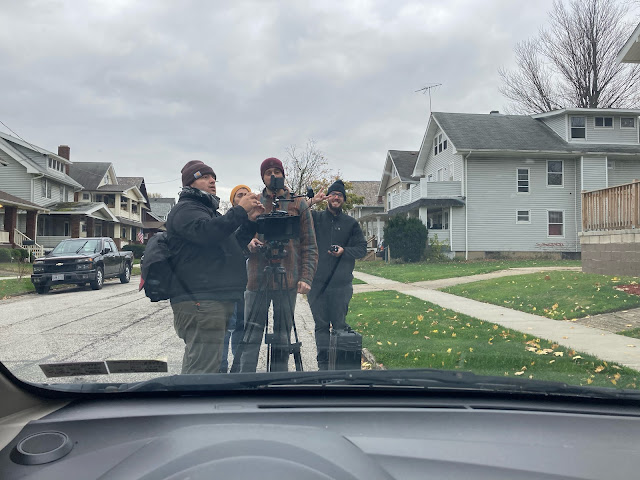
Behind the scenes on 'Culantro Fino'
Early work and endless education
MMM: Tell me a bit about your early work. Share some mistakes, what you learned from them, and some triumphs, and what you learned from those.
FL: My first film was a black-and-white short I worked on with my cousin. We shot it with just the two of us, a couple of actors, a couple of extras, and two locations. I remember as we edited, we noticed that the actor had his glasses on for an entire scene, so we had to re-schedule that whole scene for a reshoot but without the glasses. We essentially forgot to ask him to take his glasses off.
After that, we put together a 48 Hour Film Project team with some guys I met through networking events, and by helping on another film set. That short film we shot won the Audience Award at the Cleveland 48HFP which was pretty cool.
At the screening and awards events for the 48HFP, I quickly learned that half of this job is networking, so I tried to connect with as many people as I could, help on as many sets as I could, and also make as many camera tests and short films as I could. I don't know that it worked, but I know that it helped build some strong relationships with other filmmakers. Some of those collaborations are still active 10 years later.
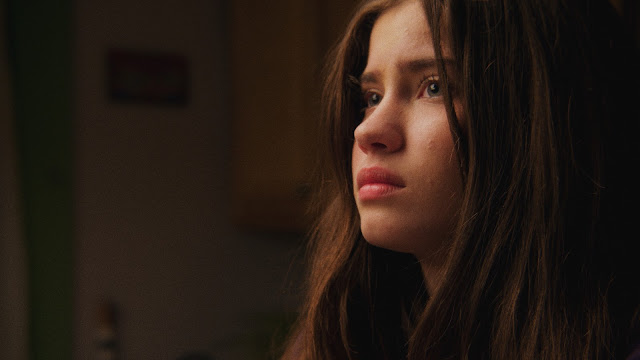
Actress Sofia Castellanos
'Culantro Fino': Complex premise conveyed in a simple way
MMM: Your latest short is Culantro Fino. What inspired you to make the film?
FL: Culantro Fino came from an alternate universe in which I write and direct a feature-length film. It takes place a few years after a story that I've been working on for the last couple of years.
I don't see more human representations of Latino, migrant families on screen. There always seems to be an element of joy and euphoria when our culture is portrayed on screen, which is not wrong, or inaccurate, but there are other versions of the Latino life in this country. Long hours working in restaurants, landscaping, diverse but dysfunctional partnerships and families, language barriers, and so forth.
We wanted to take a complex premise and convey it in a simple way, without letting technology overshadow the tenderness of the relationship or the subtext of the plot.
 |
| Sarah Carleton, left, and Sofia Castellanos - Photo: Zac Popik |
FL: The script was only five pages, but the entire universe of this story was discussed with the actors, and an additional screenplay was made available to them in which the events of the father being detained take place. Sarah and Sofia also had time to do table reads, and time to discuss the story amongst themselves. I was in constant communication with them leading up to the shoot.
Two other elements that help my process are rehearsals close to the shoot date on location, as well as using long takes with multiple runs per take. This allows adjustment without the distraction of resetting lights, makeup, props, checking batteries, media, and so forth. Not that any of these other aspects are ignored, but I find that after a couple of runs, actors begin to really let go of their doubts about the characters. They stop worrying about their marks and their lines. Then emotion and subtext become a lot more palpable.
I also find myself providing direction mid-run, which can be challenging for a lot of actors, but it is very helpful when there are unexpected ideas, or after you feel you have what you need and you can afford to experiment.
MMM: For those of us unfamiliar with the realities of deportation and immigration in the U.S., can you share moments in the film that those familiar with that experience would recognize?
FL: Certainly! One of the biggest challenges when dealing with deportation or the threat of deportation is finding legal representation. But an even bigger challenge is finding the money to pay for it.
Early in the film, we see a stack of letters from the USCIS or Department of Homeland Security. We also see invoices from an immigration law firm. These are standard immigrant family correspondence. I still guard my residence and citizenship correspondence safely and consider it to be an important period of my life.
In the film, the mother is in financial distress, talks about not getting enough hours at work, and even ordering takeout for her and her daughter is something she has to really think about - all while sheltering her daughter, who is already suffering physically and emotionally. I prefer a viewer miss these subtleties completely, rather than misinterpret them as melodramatic or exaggerated, which they are not at all.
The financial toll of deportation or even the threat of deportation on a family can be traumatic, not unlike an unexpected death in the family, a bad divorce, or bankruptcy.
MMM: The final shot is quite moving, as well. Can you tell me more about it?
FL: Our idea was to visually highlight the physical wound and to leave the frame be for a few seconds while the mother is in the background scrambling. I think this is a very clear representation of what they are going through as a family: the pain, the stress, the uncertainty, and a void that can be difficult to ignore.
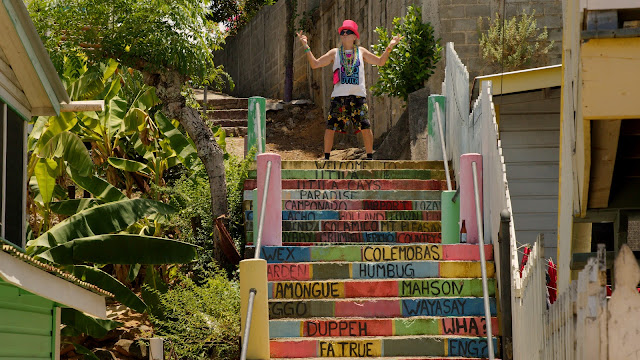
A scene from Fernando Lopez's upcoming documentary
Filmmaking future
MMM: What’s next for you?
FL: I'm working on a feature documentary that I filmed in Honduras. It is about a doctor from Akron who moved south to have a life that matched his personality. It touches on the practice of medicine on a relatively remote island, his personal struggles adapting to that society, and it also explores the subject of immortality. I'll be sharing some of that content as we round third, but it is taking a lot more time and work, though we are super excited to share it!
MMM: How would you like to see your film career grow?
FL: At this stage, I would trade growth for consistency in my career. It makes me very happy to put out smaller, meaningful projects. Projects that I work on with my friends and projects that connect with people because of the subject matter, not because of the technique, the success, or the virality of the final product. Would it be nice to have a budget and make my version of Don Quixote in a modern world, chasing evil corporations instead of windmills? Sure! But I would not want to sacrifice the pleasure I get out of my current way of working for half of that.
MMM: Final thoughts?
FL: I really appreciate the opportunity to talk about our work, our process, my friends, and thoroughly enjoyed our conversation. People can follow me on Instagram and YouTube.
Connect with Midwest Movie Maker on Facebook and Instagram …… and don’t forget to subscribe to the Midwest Movie Maker newsletter

Comments